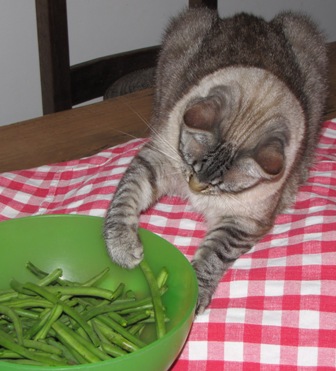In a recent “Blood” Table of Contents I read that a link has been established between pesticide exposure and MGUS. A team of researchers examined a select group of participants in the Agricultural Health Study, which began back in 1993. They determined that, compared to a control group, these farmers faced twice the risk of developing MGUS. In the study abstract (http://tinyurl.com/mjpcrh) we can read that exposure to pesticides has previously been linked to excess risk of multiple myeloma, albeit inconclusively. Well, you can take a look at the abstract on your own; I will focus only on the full study (grazie mille, Sherlock!)…
…from which I will take a few excerpts, such as the following: Although the cause of MGUS and multiple myeloma remain [sic] largely unclear, previous cohort and case-control studies have reported an elevated risk of multiple myeloma among farmers and other agricultural workers. More specifically, pesticides (ie, insecticides, herbicides, fungicides) have been hypothesized as the basis for these associations. However, most prior investigations have been hampered by small numbers and limited exposure assessment.
The Agricultural Health Study of 57,310 private and commercial licensed applicators of restricted use of pesticides enabled researchers to determine that there was a 1.34-fold […] excess risk of multiple myeloma among pesticide applicators compared with population rates in Iowa and North Carolina.
Furthermore, Several pesticides widely used on farms and in homes and gardens by the general public were associated with increased multiple myeloma risk in previous analyses coming from this cohort. Currently, however, it is unclear whether the observed increased risk of multiple myeloma among persons exposed to pesticides might reflect a higher prevalence of MGUS or an increase in the rate of progression from MGUS to multiple myeloma. Unclear or not, this study confirms what we all know or should know: pesticides, insecticides and herbicides are very very VERY bad substances. That is why my entire family eats only organic vegetables…
But let’s keep reading. The team of researchers used the Agricultural Health Study to carry out (my emphasis) the first population-based study of MGUS in relation to pesticide exposure in a sample of 678 male pesticide applicators. They discovered that 38 (5.6%) of these workers had MGUS. But read this: nobody under the age of 50 had MGUS…that adds up to a total of 123/678 men. So MGUS was detected only in the older-than-50 group.
The team also looked at 50 (!) specific pesticides, of which the worst, in terms of being MGUS risk factors, were: the chlorinated insecticide dieldrin, the fumigant mixture carbon-tetrachloride/carbon disulfide, and the fungicide chlorthalonil. Further on: Our analyses point to possible links with dieldrin, a chlorinated insecticide, which had a significant 5-fold excess risk of MGUS prevalence, and carbon tetrachloride/carbon disulfide mix, a fumigant, which had a significant 4-fold risk of MGUS prevalence. Holy cat! Other potentially dangerous substances are also mentioned…such as Permethrin, a commonly used insecticide that has been linked to multiple myeloma, another insecticide called chlorpyrifos, and two herbicides—atrazine and glyphosate.
The researchers conclude that (again, my emphasis) several million Americans use pesticides for which we have found an association with MGUS in the Agricultural Health Study. Some of these same chemicals have been associated with excess multiple myeloma risk. […] Future studies are needed to improve our knowledge on the role of pesticide exposure in the pathogenesis of MGUS, as well as the potential role in progression from MGUS to multiple myeloma.
I am almost 100% positive that this is the first study to link MGUS to exposure to commonly used insecticides, herbicides and so on. This bit of news is rather unsettling, to say the least. By the way, if you use any toxic stuff in your garden and would like to have a look at the Table listing the various substances tested (more than 30), drop me a note.
After reading this study, I am sooo glad that our garden is completely organic. Sure, we are bothered by weeds, but we don’t use herbicides; we simply do a bit of weeding whenever possible. Weeds are annoying but they can’t kill us. And yes, our garden has been invaded by pests of all sorts, from tiny aphids to big snails, but we have never used insecticides to get rid of them. We either use nothing at all, or, when things get really bad, I make up a spray bottle with natural homemade mixes. True, this way we lose a certain number of raspberries and figs and whatnot, but so be it. I would rather be safe than poisoned!
I do have a confession, though: every spring for the past few years, I have periodically used a Bayer ant spray to keep ants from marching through our house…it releases a sort of smelly foamy poison (I am now too scared to check the active ingredient…!) that is supposed to create an anti-ant barrier for three months. Now, since I have used that insecticide only in recent years, I know it didn’t cause my (former) MGUS. Even so, I am now seriously thinking of taking up Cathy’s suggestion to use corn meal instead! I also just did a quick online search and found heaps of helpful suggestions on natural non-toxic ways to keep ants from becoming too bothersome. I am going to try a few of those…and from this day forward, there will be no more toxic poisons in or around my house!
Link to the Agricultural Health Study: http://aghealth.nci.nih.gov/index.html
 And the beneficial effects of laughter are apparently long-lasting–up to 24 hours after watching a funny movie. 24 hours!, wowie. This article has given me an incentive to find and post more funny stuff and build up my
And the beneficial effects of laughter are apparently long-lasting–up to 24 hours after watching a funny movie. 24 hours!, wowie. This article has given me an incentive to find and post more funny stuff and build up my 